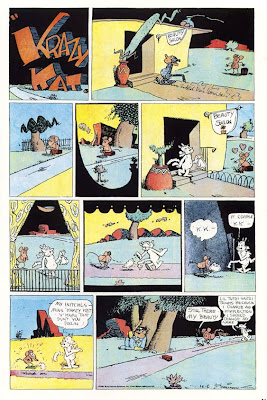George Herriman was born this day in 1880, he would have been 129 years old today.
 A lot of times when creative people are discussed, the word "genius" gets thrown in to the adjectives. Too often. To the point of losing it's meaning and power. I try not to do that.
A lot of times when creative people are discussed, the word "genius" gets thrown in to the adjectives. Too often. To the point of losing it's meaning and power. I try not to do that. I admire a lot of cartoonists and when reviewing their life's work I am impressed with their individuality, their creativity, their artistic style, their storytelling, etc., but the only one that I can without a doubt and without fear of needing to prove my point, call a genius...is George Herriman.
Herriman was born in 1880 in Louisiana and moved to Los Angeles at a young age. He got a job as a spot illustrator and engraver at the Los Angeles Herald-Examiner and was soon starting comic strips of his own. He did a number of them, but one worth noting is "The Dingbat Family" or "The Family Upstairs". This was a simple and straight-forward domestic comedy strip, but what set it apart was, along the bottom of each panel, either below the main characters' feet or even under the floorboards, was a completely different storyline going on between the family cat and a mouse. This cat and mouse were spun off into their own strip in 1913 called "Krazy Kat and Ignatz", then just "Krazy Kat" and the rest is history.
Pictured below are the main characters, Krazy Kat, Ignatz Mouse and Offisa Pup.
 Pictured below is the main thrust (only apparently) of the strip. Ignatz beans Krazy with a brick as Krazy dreams of his "Lil' Anjil", Ignatz.
Pictured below is the main thrust (only apparently) of the strip. Ignatz beans Krazy with a brick as Krazy dreams of his "Lil' Anjil", Ignatz. Offisa Pup loved Krazy Kat, Krazy Kat Loved Ignatz Mouse, Ignatz Mouse loved to throw bricks at Krazy Kat, Offisa Pup would throw Ignatz Mouse in jail...and the cycle continued. A love triangle with non-gender specific protagonists.
Offisa Pup loved Krazy Kat, Krazy Kat Loved Ignatz Mouse, Ignatz Mouse loved to throw bricks at Krazy Kat, Offisa Pup would throw Ignatz Mouse in jail...and the cycle continued. A love triangle with non-gender specific protagonists.It wasn't the story that was told that made it great, it was the WAY the story was told that Herriman's genius went to work on.
Set in Coconino County, AZ., the sets that all this action took place in were a joy to the eye. Done in the time when a Sunday comic strip took up the entire page of the newspaper, these scenes are a joy to behold. Herriman's stylist page layouts combined with this beautiful surreal desert to create a different world. Cacti and trees grew, not from the desert sands, but from terracotta pottery scattered over the desert floor, decorated in Navajo designs. Art deco mesas loomed in the distance and even the shadowed phases of the moon were three dimensional cutaways of a chunk in the sky.
The language was as poetic as the visuals. The characters speak phonetically making what they're saying appear child-like, but the turn of phrases even turn of concepts is true poetry on the highest order.
I do an injustice to Herriman's work trying to analyze something that was so organic to him. Check out these few examples of his work.


 The strip was adored by the art elite and intellectuals of the day, but the general public (the "mooks du jour") didn't understand it and wrote letters to the papers saying so, a sure coffin closer for any feature. Except for one thing...or one man I should say. One of it's admirers was William Randolph Hearst. He owned the newspaper syndicate. The strip ran from 1913 until Herriman's death in 1944. 33 years. All you need is the right champion, and something worthwhile can actually succeed. :)
The strip was adored by the art elite and intellectuals of the day, but the general public (the "mooks du jour") didn't understand it and wrote letters to the papers saying so, a sure coffin closer for any feature. Except for one thing...or one man I should say. One of it's admirers was William Randolph Hearst. He owned the newspaper syndicate. The strip ran from 1913 until Herriman's death in 1944. 33 years. All you need is the right champion, and something worthwhile can actually succeed. :)In 1999 The Comics Journal had a poll for the top 100 comics of the 20th century. This included both comic strips and comic books. Krazy Kat was number 1.
When Herriman died, the common practice of the day was to replace the artist with another to continue on the feature, after all most comic strips are owned by the syndicate, not the artist. But Hearst said no in this case. No one could replace George Herriman. Krazy Kat was too personal a project. A sure sign of genius.
Herriman's ashes were scattered from an airplane over Monument Valley, Arizona. Coconino County will always be his home.
Thanks George!




No comments:
Post a Comment